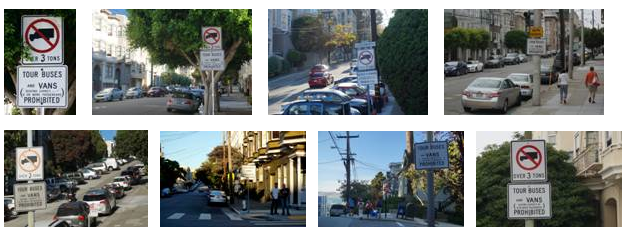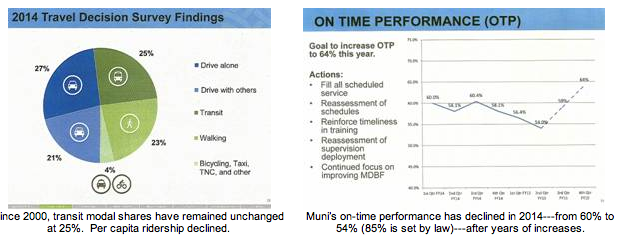Private Shuttle Buses: Need EIR to Plan Future
 1. Negative environmental impacts on Muni, streets and neighborhoods
1. Negative environmental impacts on Muni, streets and neighborhoods
2. Violations of existing vehicle codes, traffic laws and street regulations
3. Transit Equality: Speed up commute times for tech workers and everyone.
1.
Holistic commuter plan is needed—to speed up travel times for everyone. Environmental Impact Report is needed.
As shown in the Budget & Legislative Analyst’s report to the Board of Supervisors, titled “Impact of Private Shuttles” (March 31, 2014), a full Environmental Impact Report (EIR) is needed for the private shuttle bus program—before it is made permanent.
· San Francisco must reinforce its Transit-‘First Policy, uncluttering Muni bus zones and congestion.
· In 2014, Muni’s on-time performance declined from 60% to 54%, as private shuttle buses increased.
· The SFMTA Board should rescind permission for shuttles to operate in public bus zones—in violation of the California Vehicle Code. Other violations include state/ local traffic laws, vehicle street restriction laws, air quality/ noise ordinances….
· The EIR should evaluate air quality impacts and degradation of street infrastructure.
· The EIR should evaluate impacts if hundreds of other companies start private shuttle service.
· The EIR should evaluate transit inequity—instead of well-heeled riders on luxury buses segregated from “low-class” Muni.
· The EIR should evaluate the impacts of private shuttle buses on property prices, rent costs, evictions and displacements of low to middle-income residents and businesses—per recent academic studies.
· The EIR should study transit integration—with public feeder lines to transit hubs, regional express bus lanes, free shuttle buses for both tech workers and the general public…..

Budget & Legislative Analyst Report: “Impact of Private Shuttles”
http://sfbos.org/modules/showdocument.aspx?documentid=48498
· “No comprehensive assessment has been completed by San Francisco Municipal Transportation Agency (SFMTA) or other City or other public agencies on the full impacts of private shuttles on City infrastructure costs, traffic and traffic delays, pedestrian and bicyclist safety or housing costs along the shuttles’ routes.”
· “The Department of Public Works and a Metropolitan Transportation Commission study both show that the large regional shuttle vehicles have significantly more impact on street repair costs than regular passenger vehicles, smaller shuttles such as vans and semi-trailer trucks.”
· “conflicts that occurred every hour in which either a Muni vehicle or a shuttle couldn’t access a bus zone because they were blocked by the other.”
· “shuttles blocking traffic by loading and unloading passengers from traffic lanes, or blocking traffic lanes by not pulling fully into a bus zone.”
· “Safety impacts on pedestrians, bicyclists and disabled passengers have not been comprehensively assessed…”

YOUTUBE VIDEO: “Five Years Later—Are [Google] Shuttle Buses Useful Or A Menace?
http://noevalleysf.blogspot.com/2014/09/five-years-later-are-shuttle-buses.html
Video shows impact of private shuttle buses on neighborhoods. Buses run before 6:30AM to 10:30AM and again from 4:30PM to after 10:30PM. There are 20+ buses per hour on different routes.
Hundreds of companies can start private shuttle routes.
In 2004, Google was the first company to start private shuttles, making 2 stops in San Francisco. Today, Google makes180 runs/ stops throughout the city—every day. Currently, a relatively small number of companies operate shuttle buses (Google, Yahoo, Genetech, Apple, Facebook, Netflix, Electronic Arts, eBay, LinkedIn…)—but already there are 2,900 stop-events per day in San Francisco. Over time, hundreds of wealthy companies can start shuttle systems, creating gridlock and a two-tiered transit system—luxury buses for the rich and a hobbled Muni for everyone else.
2.
MAP: S.F. Restricted Traffic StreetsTour Buses (over 8 passengers) are currently prohibited from many neighborhood streets. And private shuttle buses are larger/ heavier than tour buses, impacting even narrower streets.
https://www.sfmta.com/sites/default/files/pdfs/Restricted%20Traffic%20Streets3%201-13-14.pdf
· Many San Francisco neighborhoods already prohibit vehicles over 3 tons and buses/ vans with 8 or more passengers. Private shuttle buses are much larger vehicles with much greater weights (over 25 tons)—operating from early mornings to late nights.
· Ignoring weight restrictions and being extra heavy, commuter shuttles are tearing up roadbeds, scraping pavement on steep streets, denting parked cars, crashing into Muni ramps and driving up maintenance costs.
· Commuter shuttles use narrow streets, blocking traffic, making awkward turns, endangering opposing traffic lanes and putting pedestrians/ bicyclists at risk—with unnecessary high legal liability.

Muni’s on-time performance declined in 2014, after years of increases.
With hundreds of shuttle runs, public bus stops/ streets have been jammed, blocking Muni vehicles, Muni bus stops, Muni boarding and traffic. If hundreds of companies start private shuttles, the impacts on Muni will grow. Private shuttles are unsustainable.

Private shuttles routinely violate requirements of Pilot Plan.
Observers find little enforcement of the Pilot Plan. Violations include no bus identification tags, use of unauthorized bus stops, use of 3-ton restricted streets, violations of vehicle codes and traffic codes.
Field observations see worsening air pollution, noise and quality of life.
Commuter shuttles clog streets, exacerbating green house gas emissions. Environmental impacts include engine idling/ emissions, bus engine/ air conditioning noise, operations on steep hills, non-source point pollution from third axle tire skids, damage to pavement, violations of size/ weight restricted streets, delays to Muni by wide turns/ boarding at Muni bus stops and streets, illegal left turns from bus curbs, traffic congestion, public safety…
EIR is needed to study impacts on rising rents, displacements and evictions.
48 HILLS: Who pays for the damage tech companies has done to SF?
I don’t think I’m the only one who has noticed a huge increase in the number of tech shuttles clogging the city’s streets. And a new study confirms that the number of shuttles is going up– and areas where there are shuttle stops have more evictions.
[MAP]: Between June 2014 and July 2015, the number of shuttle bus stop events in San Francisco increased by 46 percent, from 2,032 to 2.978. According to the SFMTA, there are now 203 shuttles in operation in San Francisco, traveling 118 routes.
[MAP]: Map showing that 69% of no-fault evictions between 2011 and 2013 happen within 4 blocks of tech bus stops in San Francisco. By the Anti-Eviction Mapping Project.
Let’s put the tech shuttles in the context of a new report outlined in TechCrunch suggesting that one-third of the rent costs in San Francisco are due to venture capital.
Yes, we have (modest) fees for affordable housing and transportation. But everyone freely admits that they are inadequate to cover the full impacts.
3.
Corporate transportation expenditures can be combined with public transit funds to create feeder lines to transit hubs, a regional express bus system and free shuttle bus loops. Highway express lanes, for carpools/ commuter buses, would speed up travel times for tech workers and the general public—transit equity. Rapid buses can also feed BART and Caltrain Stations. The Bay Area Regional Express Bus Plan Study should be implemented—by combining corporate and public transportation funds.ALTERNATIVE SOLUTIONS: Regional express bus lanes can get all commuters to work faster—because even private shuttles are stalled in highway gridlock.
Tech Partnerships: Commuter cloud-based software, apps and consolidated funds.
Public transit and tech commuter needs can be merged for mutual gains. Technology can significantly simplify transit-management—the objective being to speed up commute times for everyone. With enhanced management of carpools and express buses, the number of vehicles on the road can be reduced and travel times accelerated—for everyone.

Free Shuttle Bus Loops are the biggest transit trend in the U.S.
Free shuttle loops are the hottest transit trend in the United States—like in Baltimore, Dallas, Raleigh, Denver, Minneapolis, Bethesda, Aspen, Long Beach, Orlando, West Palm Beach, Scottsdale, Charlotte, Oakland, Emeryville, San Jose, Walnut Creek, Palo Alto, East Palo Alto, Mountain View, South San Francisco, PresidioGo, UCSF, Mission Bay…..
Mountain View: “Free shuttle to connect tech companies and downtown”
http://www.mv-voice.com/news/2014/12/10/free-shuttle-to-connect-tech-companies-and-downtown
The service will be a consolidation of five separate employer shuttle systems. “Through this consolidation, approximately 12,000 shuttle vehicle miles are saved per year,” said Denise Pinkston, chair of the board operating the system.
The biggest employers and office developers in the city are paying for the service, including Google and LinkedIn, thanks to a requirement placed on new office development by the Mountain View City Council.
We urge compliance with existing laws, rescinding use of public bus stops, prioritization of the Bay Area Regional Express Bus Plan Study and an EIR of the private shuttle bus program before it is made permanent—to foster a faster, regional commuter system.
SaveMuni = FRISC
Fast, Frequent, Reliable, Inexpensive, Safe, Clean and “Cool”.
SaveMuni is San Francisco’s only independent transportation think tank,
dedicated to improving the entire Muni transit system in every neighborhood quickly and inexpensively—with best practices from around the world, transit-preferential streets, bus rapid networks and high benefit-to-cost infrastructure projects.
Contact: Howard Wong AIA

